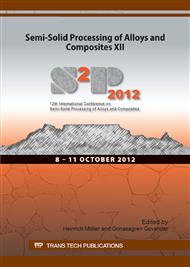p.72
p.76
p.83
p.89
p.95
p.101
p.109
p.116
p.123
Mechanical Properties of Hypo/Hyper-Eutectic Al-Si Bi-Metal Composite Parts Prepared by Thixo-Forging
Abstract:
Hypo/hyper-eutectic Al-Si bi-metal composite parts were prepared by the strain-induced melt activated (SIMA) thixo-forging. The interfaces of the bi-metal composites were observed using OM, and SEM. The tensile strength and hardness of the matrix alloys and the bonding strength at the interface were assessed by tensile test and micro-indent test. Results show that the eutectic structure joined together on the interface under the pressure. However, there are some defects such as holes and impurities were found near the interface. The tensile test samples were broken in Al-20 wt. % Si matrix. The bonding strengths at the interfaces were higher than 80 MPa. Results show that the hardness gradually increasing from 55 HV in Al-7 wt. % Si alloy to 180 HV in Al-20 wt. % Si alloy, which demonstrate the composite interface transited smoothly. The composite interface has an average hardness of 80 HV.
Info:
Periodical:
Pages:
95-100
Citation:
Online since:
October 2012
Authors:
Price:
Сopyright:
© 2013 Trans Tech Publications Ltd. All Rights Reserved
Share:
Citation:


